
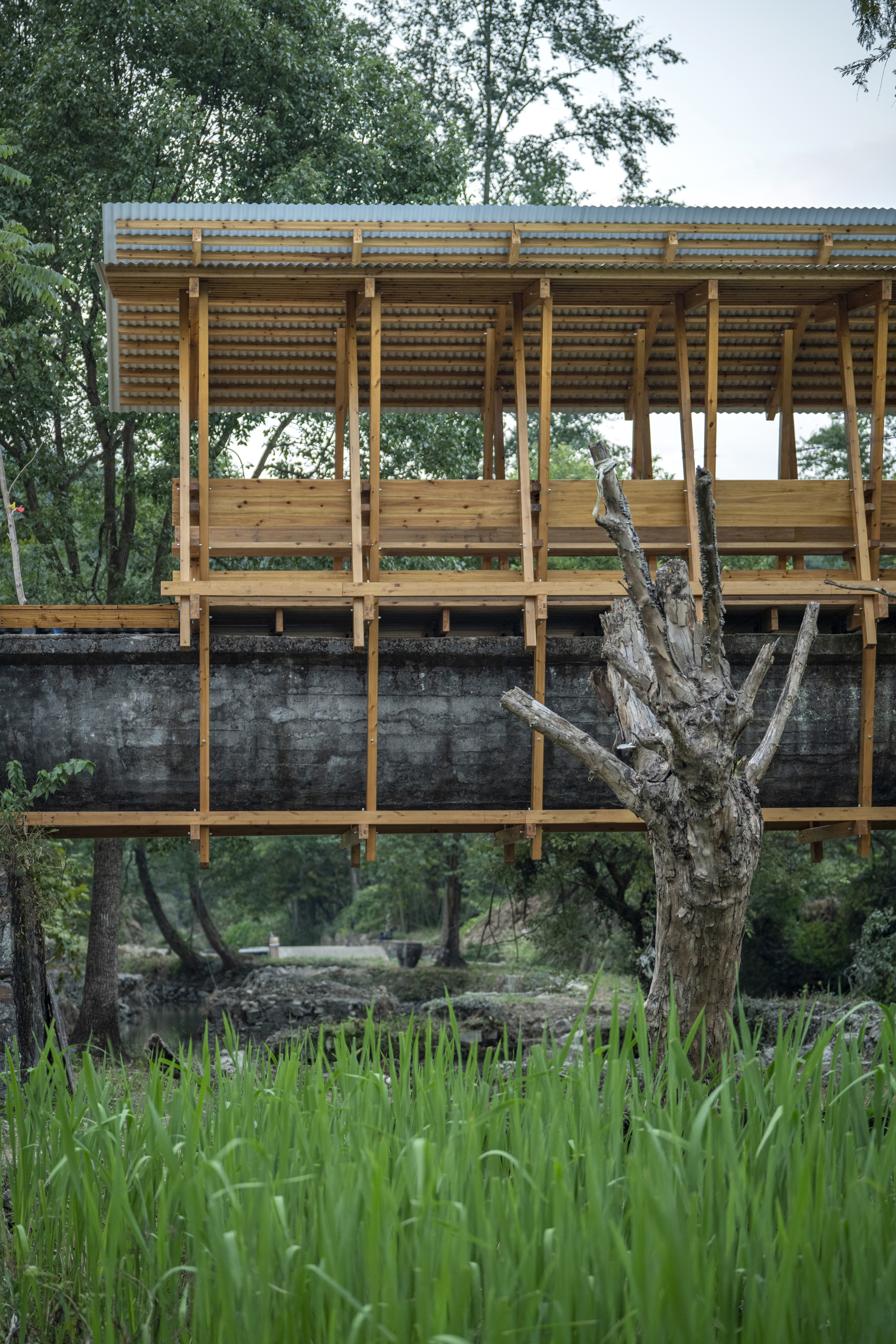
建筑设计 IARA设计研究事务所
项目地点 安徽黄山
施工时间 2023年10月
建筑面积 105.6平方米
摄影 宋惠恩、吴心然
项目位于黄山市黟县碧阳镇的丰梧村。作为皖南传统村落保留最完好的区域,黟县拥有丰富的自然景观和人文存续,更拥有西递、宏村等久富盛名的徽州古村落。然而,相较于黟县的其它文化名村而言,丰梧村虽然田园风光秀美,但古建筑留存有限,面临着许多普通村庄都会面临的问题,比如人口外流、老龄化、公共设施不足、文化生活匮乏等。
The project is located in Fengwu Village, Biyang Town, Yixian County, Huangshan City. As the most well-preserved area of traditional villages in southern Anhui, Yixian County boasts rich natural landscapes and cultural heritage, including renowned ancient villages like Xidi and Hongcun. However, compared to other culturally famous villages in Yixian County, despite the picturesque rural scenery of Fengwu Village, the preservation of ancient buildings is limited. It faces common challenges that many ordinary villages encounter, such as population outflow, aging demographics, insufficient public facilities, and a lack of cultural activities.
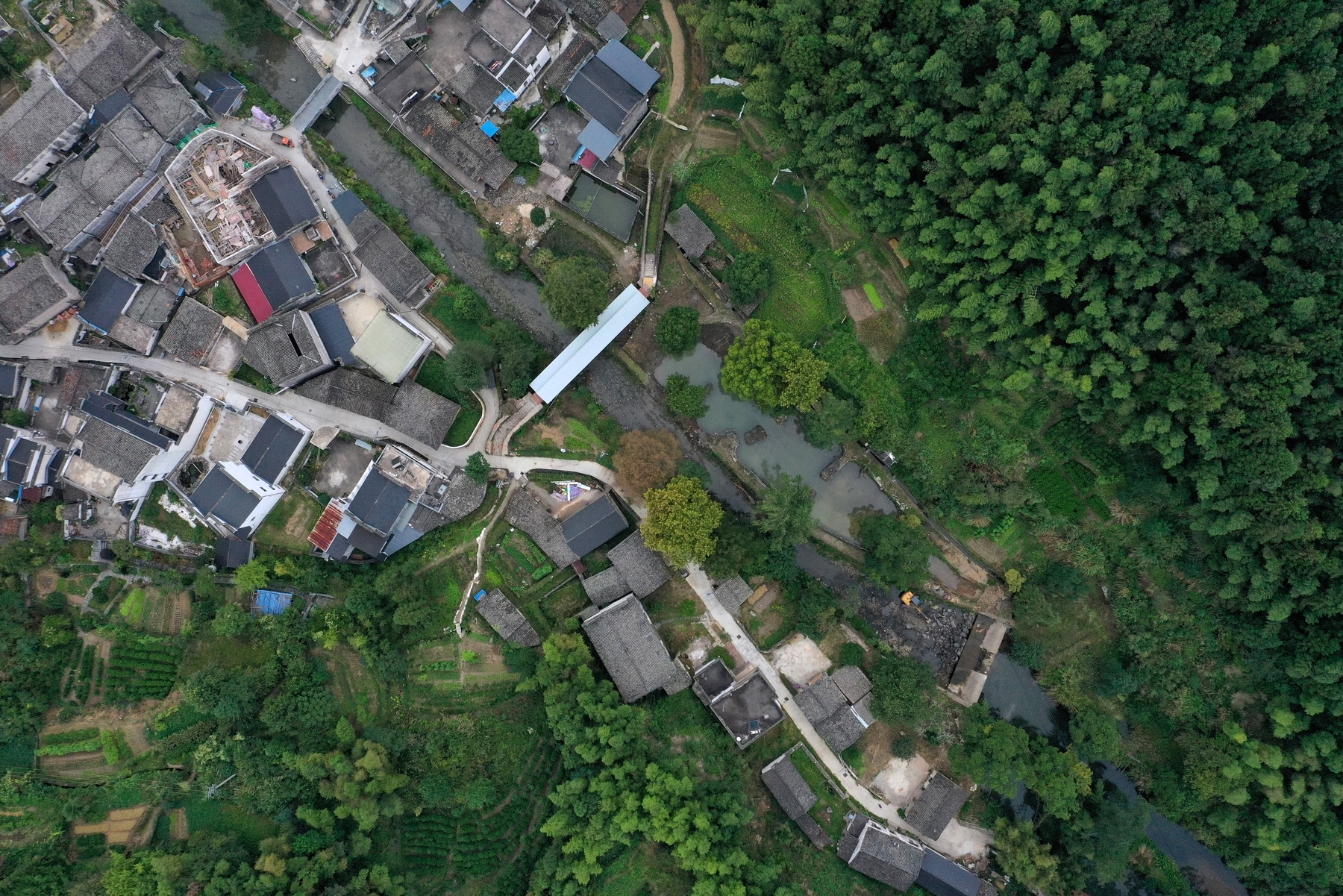
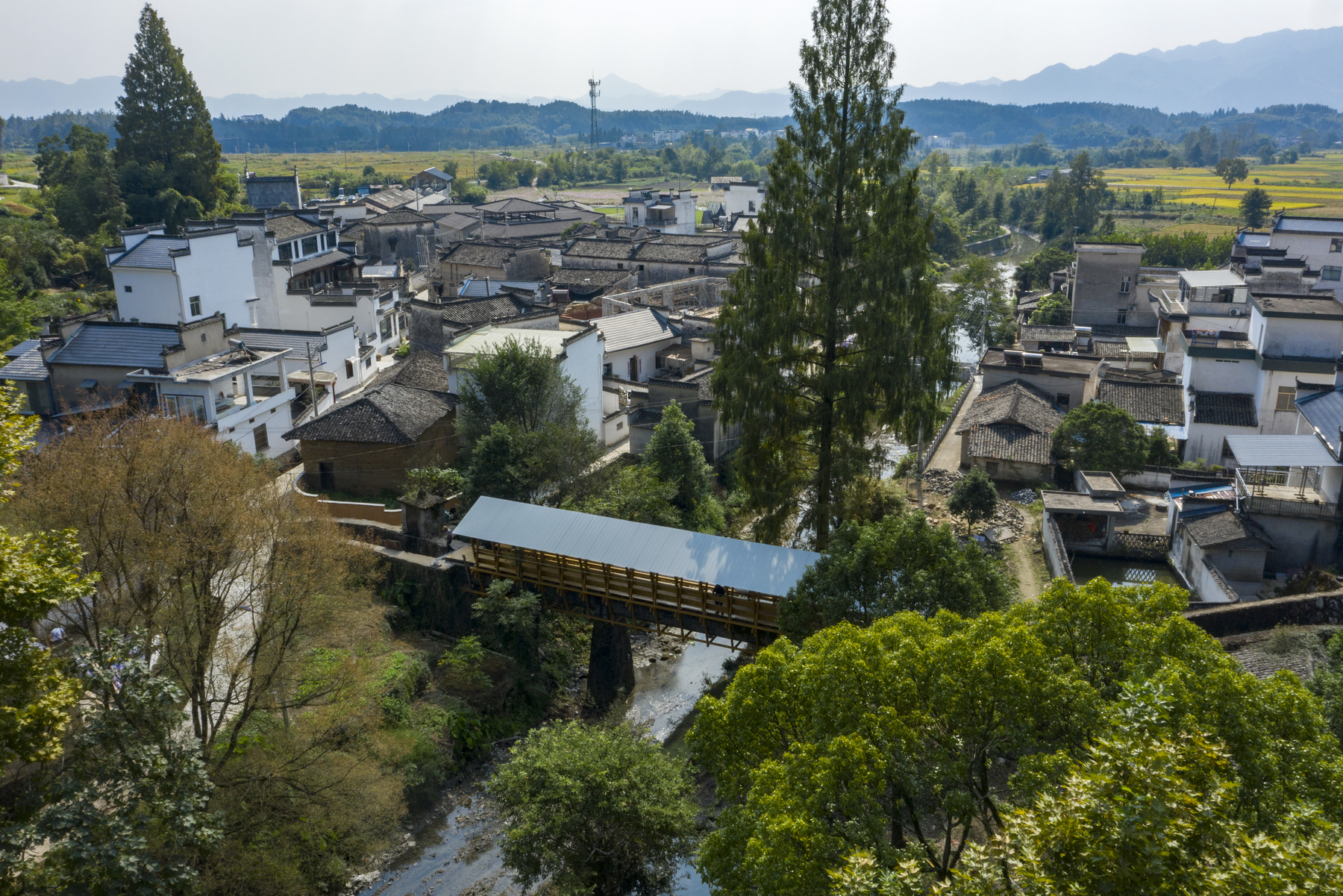
如何利用设计的力量为这一普通的村庄注入活力?我们在2023年发起了乡村活化公益项目“丰梧季”,旨在从国际视野和乡土在地性的角度出发,以空间为载体,结合在地村民与社会各界的力量,通过村庄微更新、乡村文化建构等方式,提升当地村民生活的丰富度和幸福感,重焕乡村活力。“水渠廊桥”正是其中的子项目。
How can design empower this ordinary village? In 2023, we initiated the rural revitalization charity project " Fengwu JI." Aimed at approaching the endeavor from an international perspective and a focus on local characteristics, the project uses space as a medium, harnessing the collective efforts of local villagers and various sectors of society. Through methods like micro-renewal and the construction of rural culture, the project seeks to enhance the richness and happiness of the local residents' lives, revitalizing the rural community. "The Covered Bridge on Aqueduct" is one of the sub-projects within this initiative.

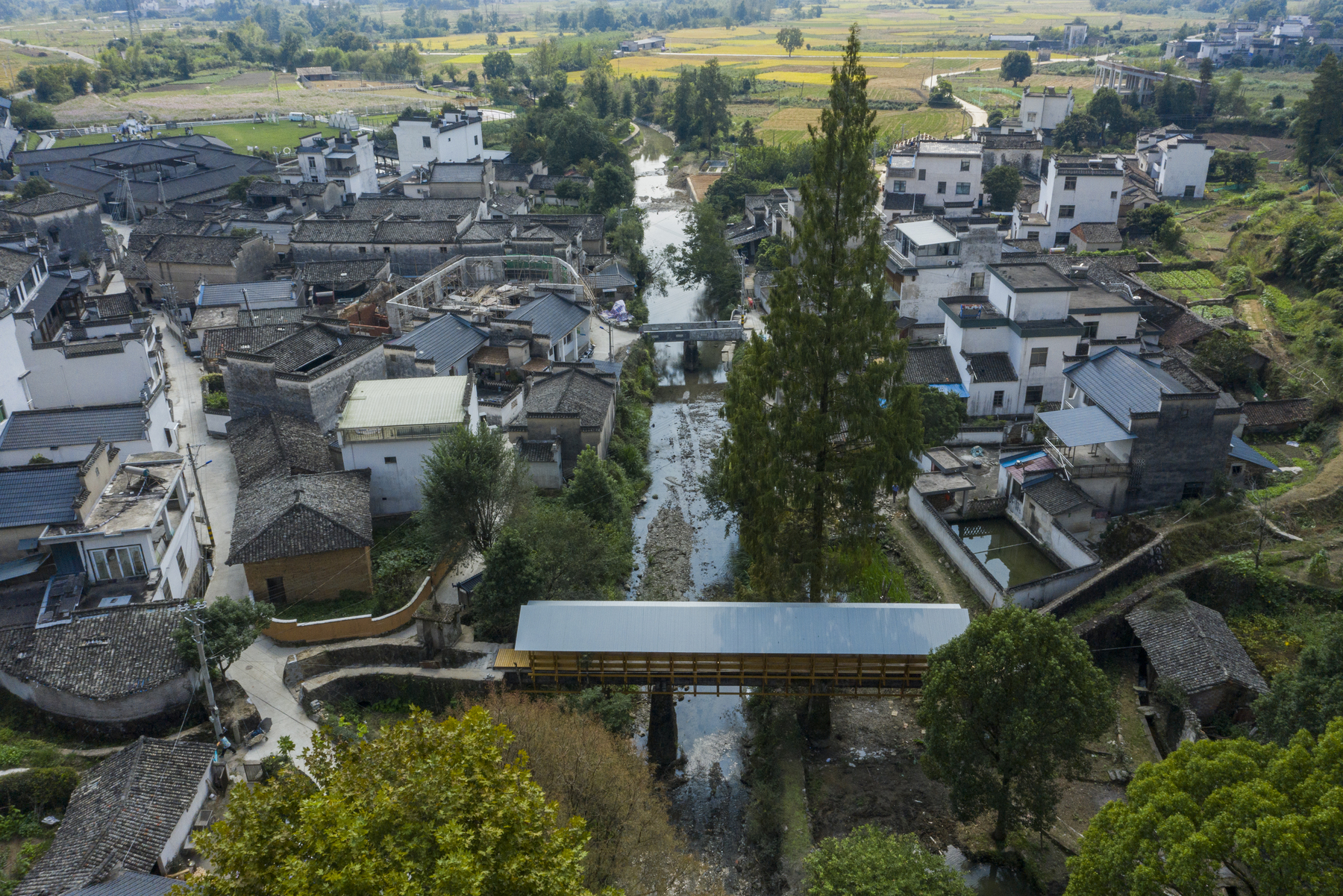
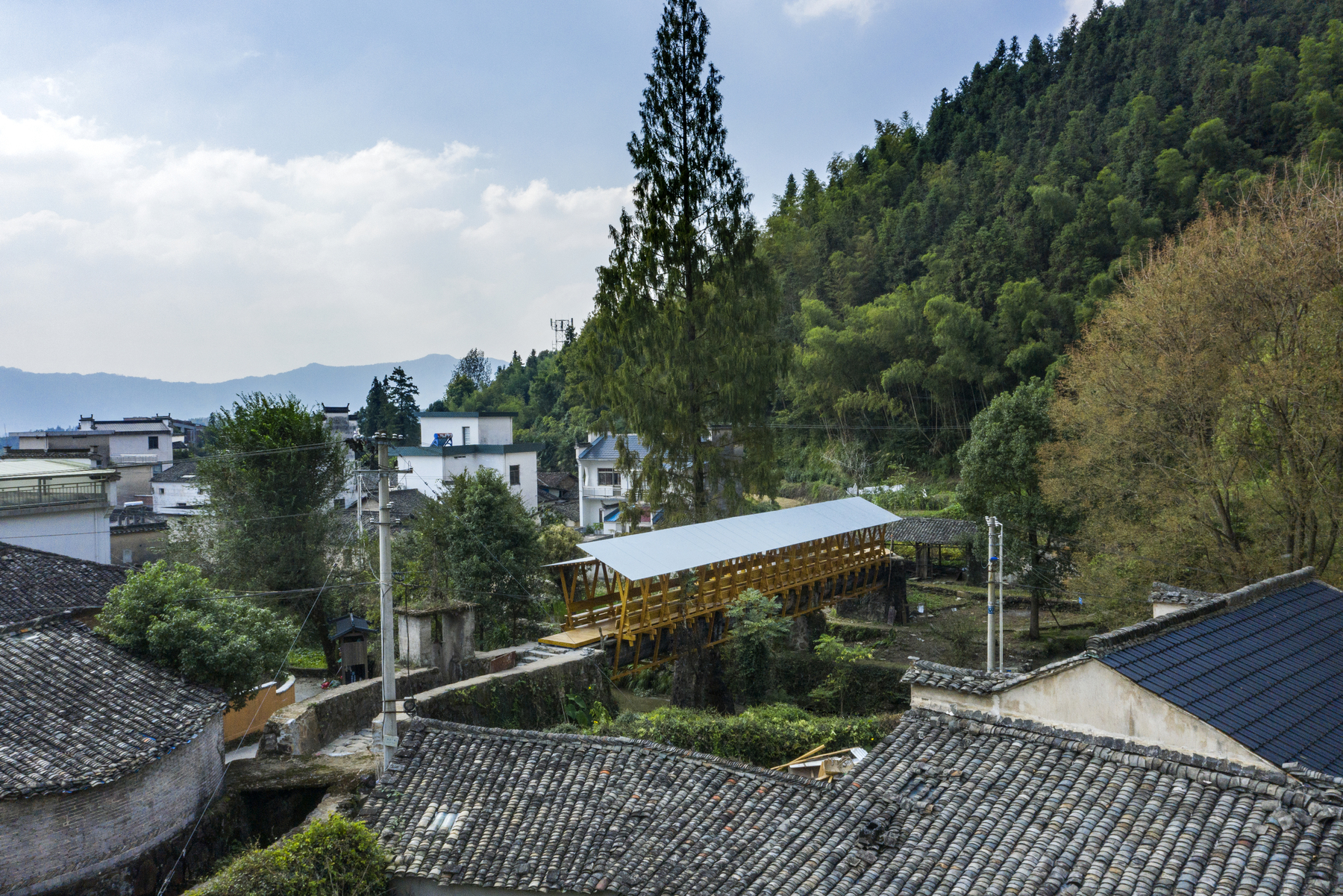
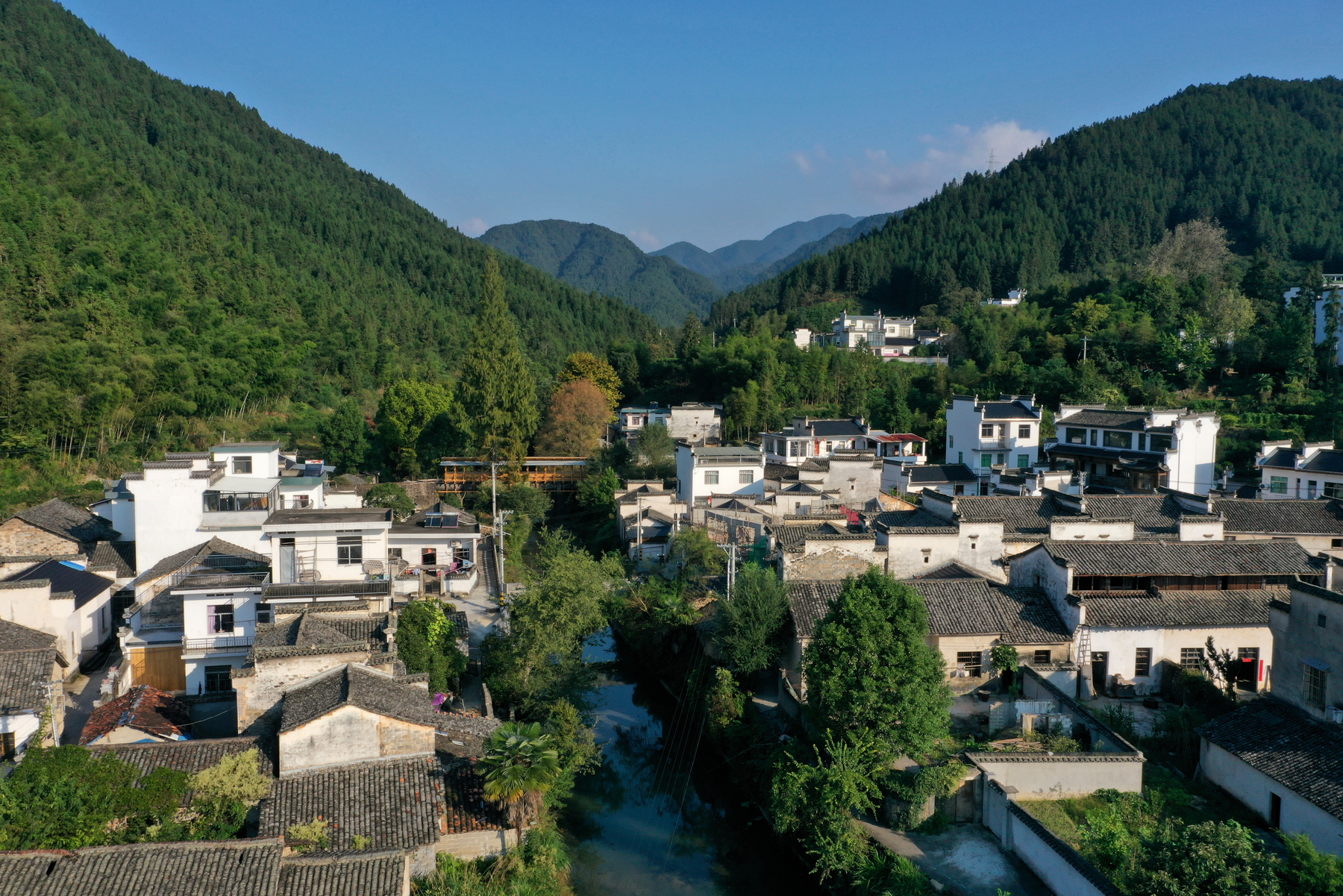
项目地点位于村庄北部的老水渠,建于20世纪60年代,曾用于从山上引水灌溉耕地,如今早已废弃,其中一段横跨村中的丰溪河上,为U型混凝土桥体结构,至今保存完好。水渠周边自然野性,郁郁葱葱。西南侧紧挨一颗老水杉,是村庄的制高点和“风水树”,旧的人工“桥渠”与老的自然杉树,对话成趣,构成独有的场所精神。
The project is located along the old water channel in the northern part of the village, constructed in the 1960s for irrigation, drawing water from the mountains to cultivate fields. Today, it stands abandoned, with a well-preserved U-shaped concrete aqueduct spanning the Fengxi River in the village. The surroundings of the aqueduct are naturally wild and lush. Adjacent to the southwest side is an old metasequoia tree, which is the highest point and "fengshui tree" of the village. The old artificial aqueduct and the natural metasequoia tree engage in a delightful dialogue, creating a unique genius loci.



在设计之初,我们对村民进行了调研,被提到最多的是记忆,有关于当年集体修建老水渠的记忆,也有对集体农业大生产的追忆,更有废弃之后,人们儿时在此捉迷藏玩耍的回忆,这些都深深地刻印在每个生长于丰梧村的村民心中。另外,在访谈中,村民普遍提及夏日需要一个吃饭、纳凉的空间。丰溪河横跨村庄,沿河道凉爽宜人,是绝佳的公共生活场所。但是村里现有的混凝土桥只有交通的功能,通风不畅,无遮阳避雨的考虑,也没有给人们留下休憩的空间。因此,在充分考虑村民的需求后,我们决定将横跨丰溪河上的这段水渠改造为一处舒适的公共廊桥,供村民日常使用。
In the initial design phase, we conducted surveys with villagers, and “memory’ was the most frequently mentioned word. These memories included recollections of the collective construction of the old water channel, nostalgia for collective agricultural production, and fond memories of playing hide-and-seek around the channel during childhood. These are deeply engraved in the hearts of every villager in Fengwu Village. Additionally, during the interviews, villagers commonly expressed the need for a space to eat and seek shade during the summer. The Fengxi River, spanning the village, provides a pleasant and cool environment along its banks, making it an excellent public space for community life. However, the existing concrete bridge in the village serves only a transportation function, lacking ventilation, sunshade, and resting spaces. Therefore, considering the villagers' needs, we decided to transform this aqueduct spanning the Fengxi River into a comfortable public covered bridge for daily use.
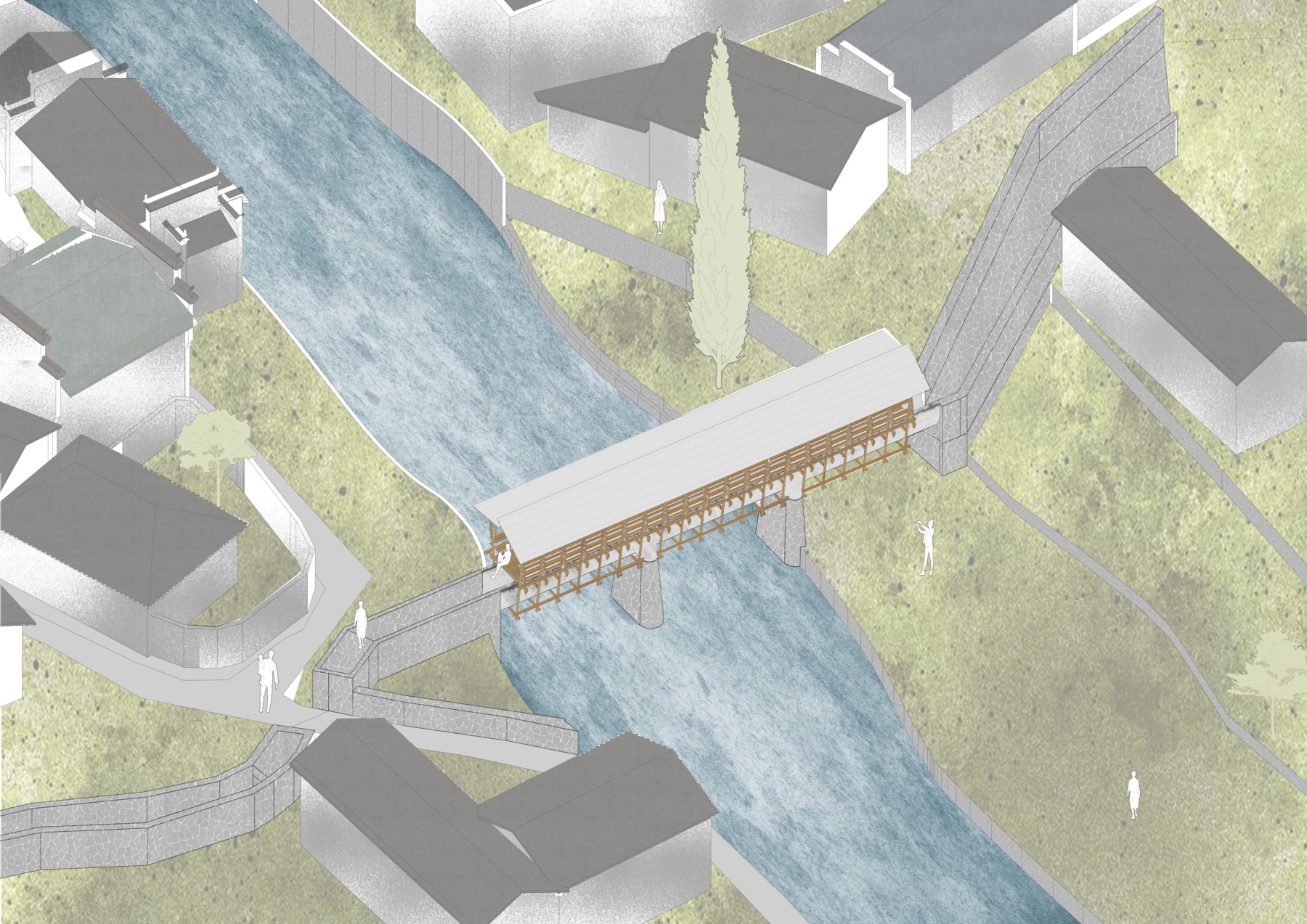
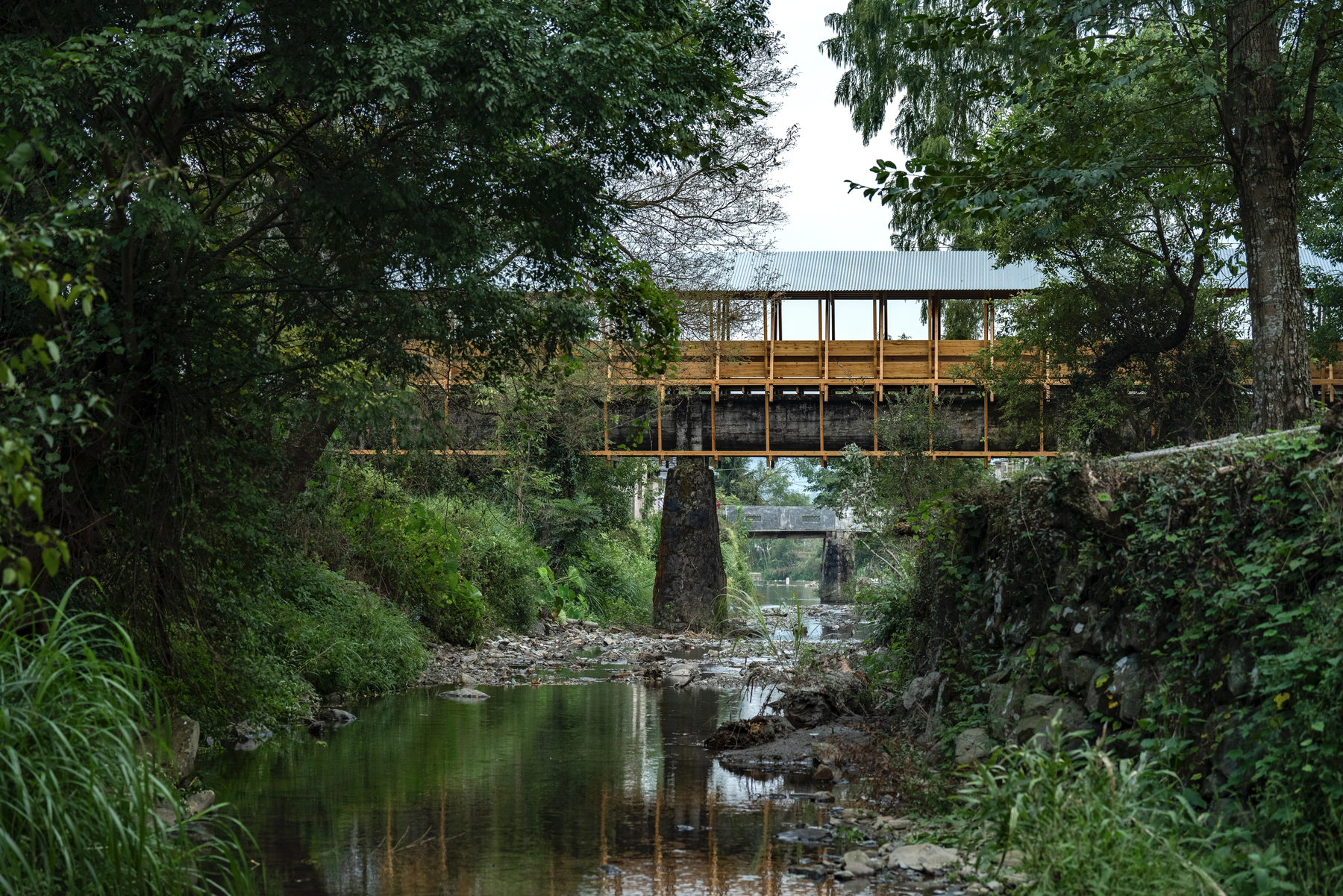
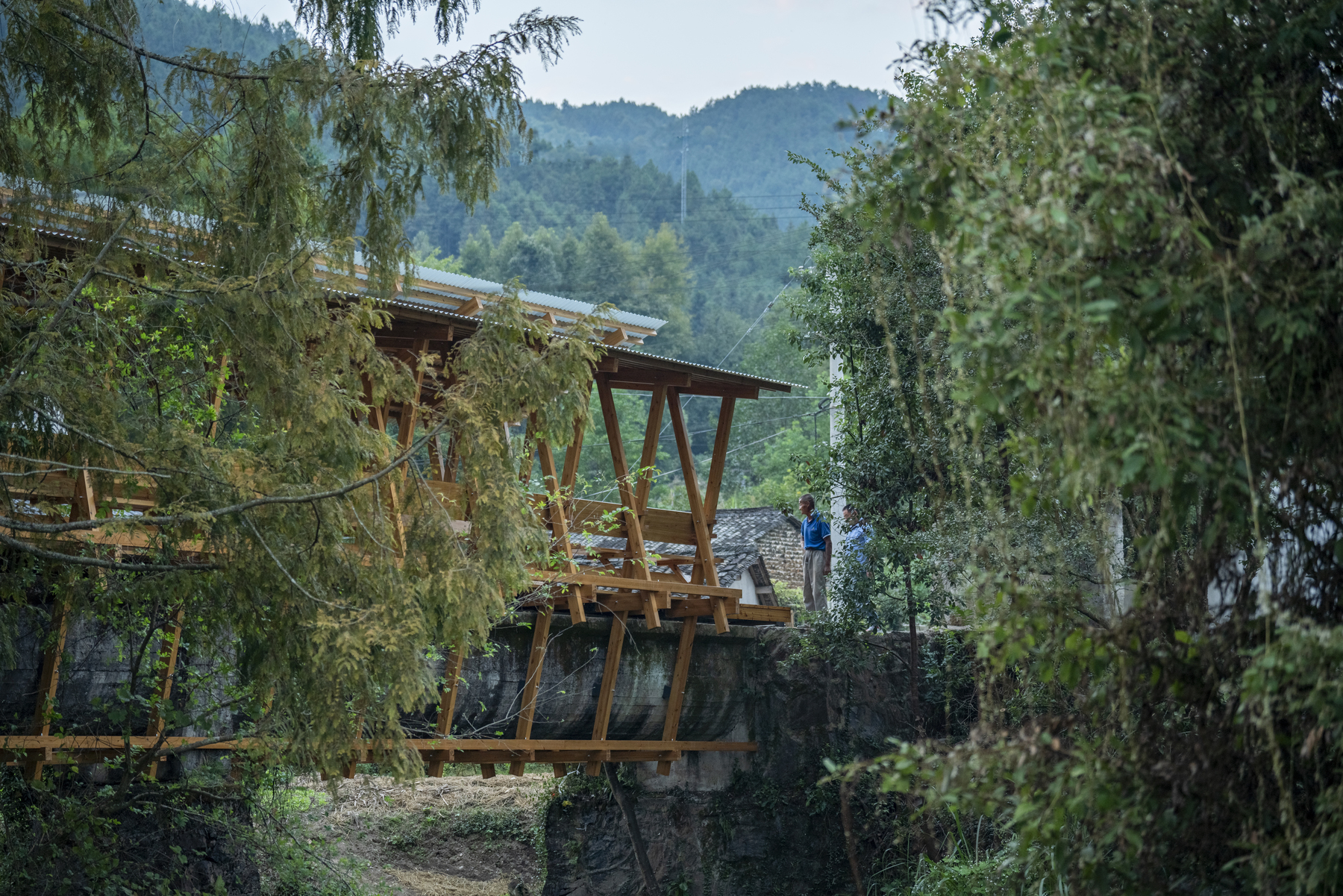
为延续村庄的集体记忆,我们将水渠本体保留下来,不止保存它的原始结构,还有它表面留下来的岁月痕迹,甚至常年生长的青苔和植被,都作为记忆的一部分,被完全保留。在老水渠的躯体上,附着一个轻质木结构桥身,如同老树干上新生的藤蔓,新廊桥让老基建的生命被重新唤醒。而木材的使用也呼应了传统徽州建筑的在地性,又提升了这个新基建与人的亲近感。同时,轻质结构也减轻了桥体自身的荷载,最大化保证了老水渠的结构安全。
To cherish the collective memory of the village, we decided to preserve the original aqueduct, not only maintaining its original structure but also keeping the traces of time imprinted on its surface, including the perennial moss and vegetation. All these elements are considered part of the collective memory and are fully preserved. On the body of the old aqueduct, we attached a lightweight wooden bridge body. Like new vines on an old trunk, the new covered bridge reawakens the life of the old infrastructure. The use of wood not only pays homage to the local tradition of Huizhou architecture but also enhances the intimacy between the new infrastructure and the villagers. At the same time, the lightweight structure reduces the load of the bridge, ensuring the structural safety of the old aqueduct to the maximum extent.
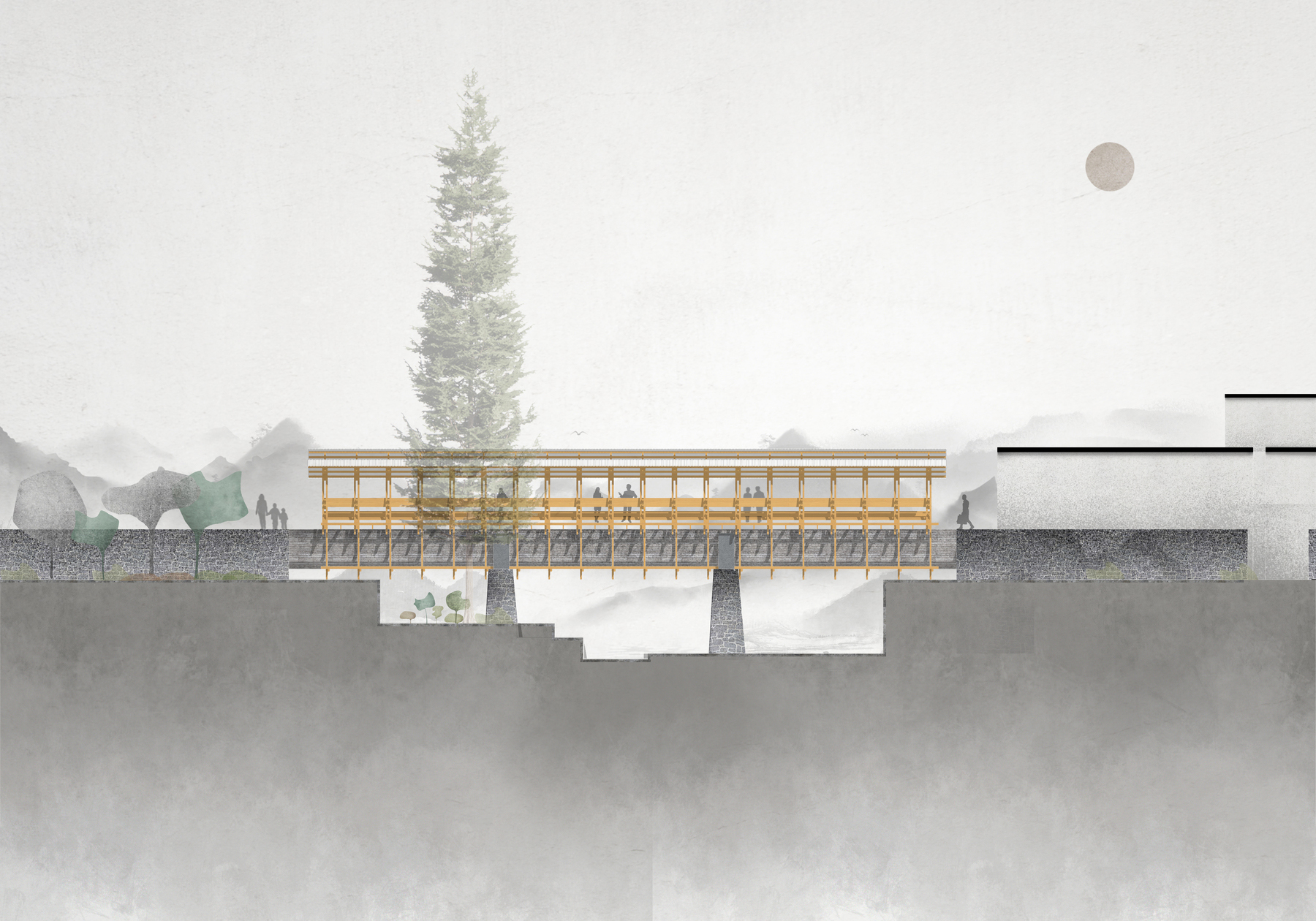
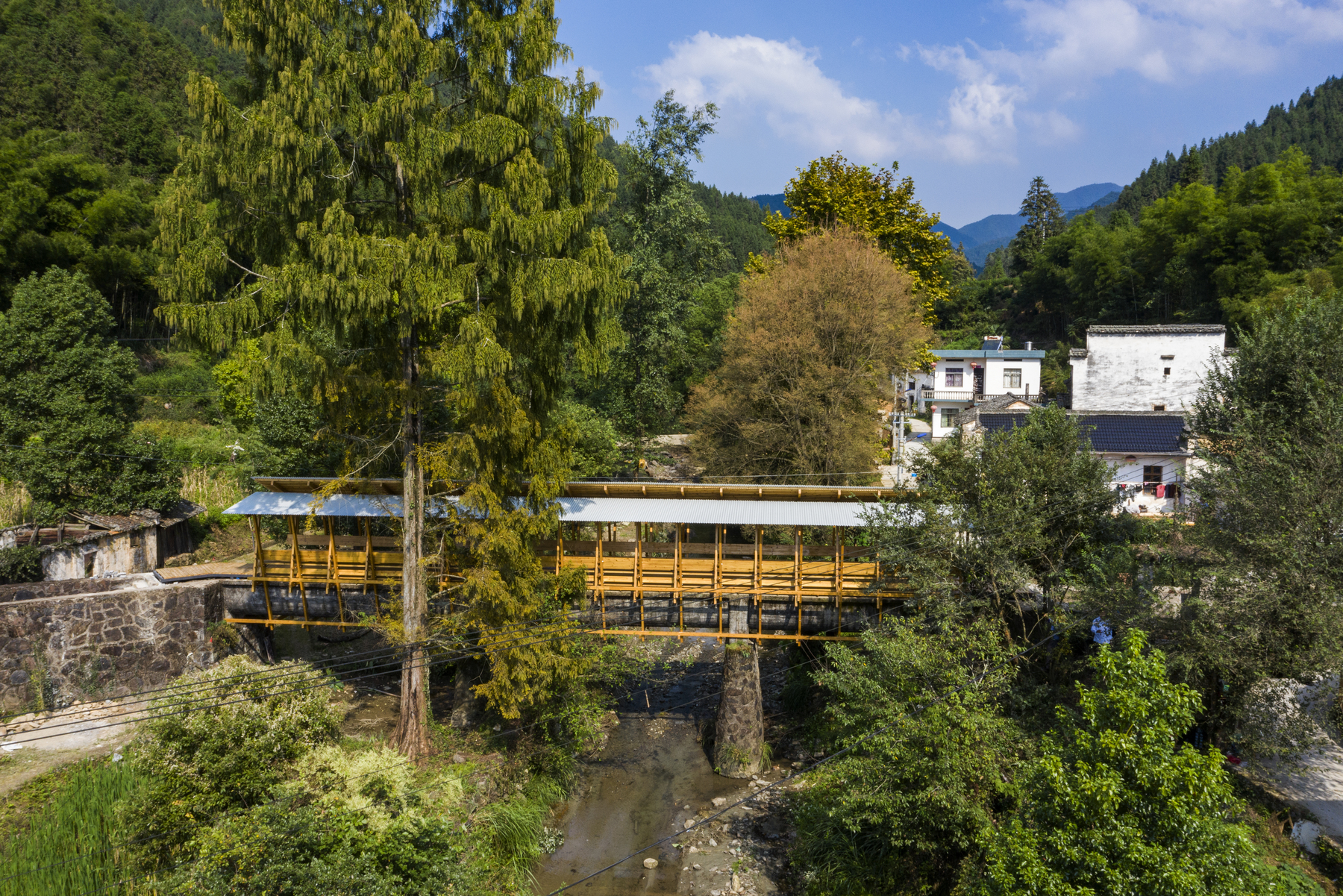
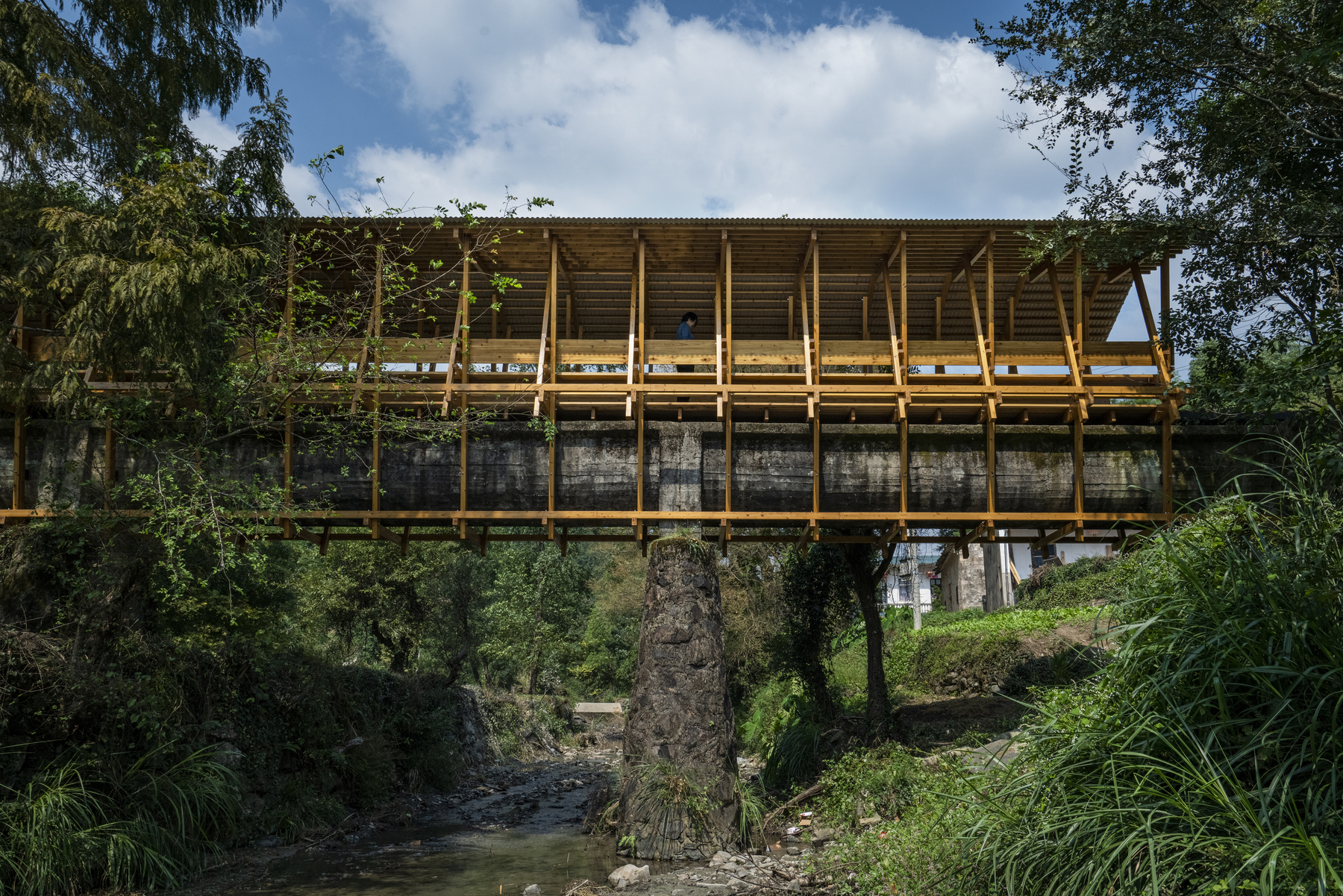
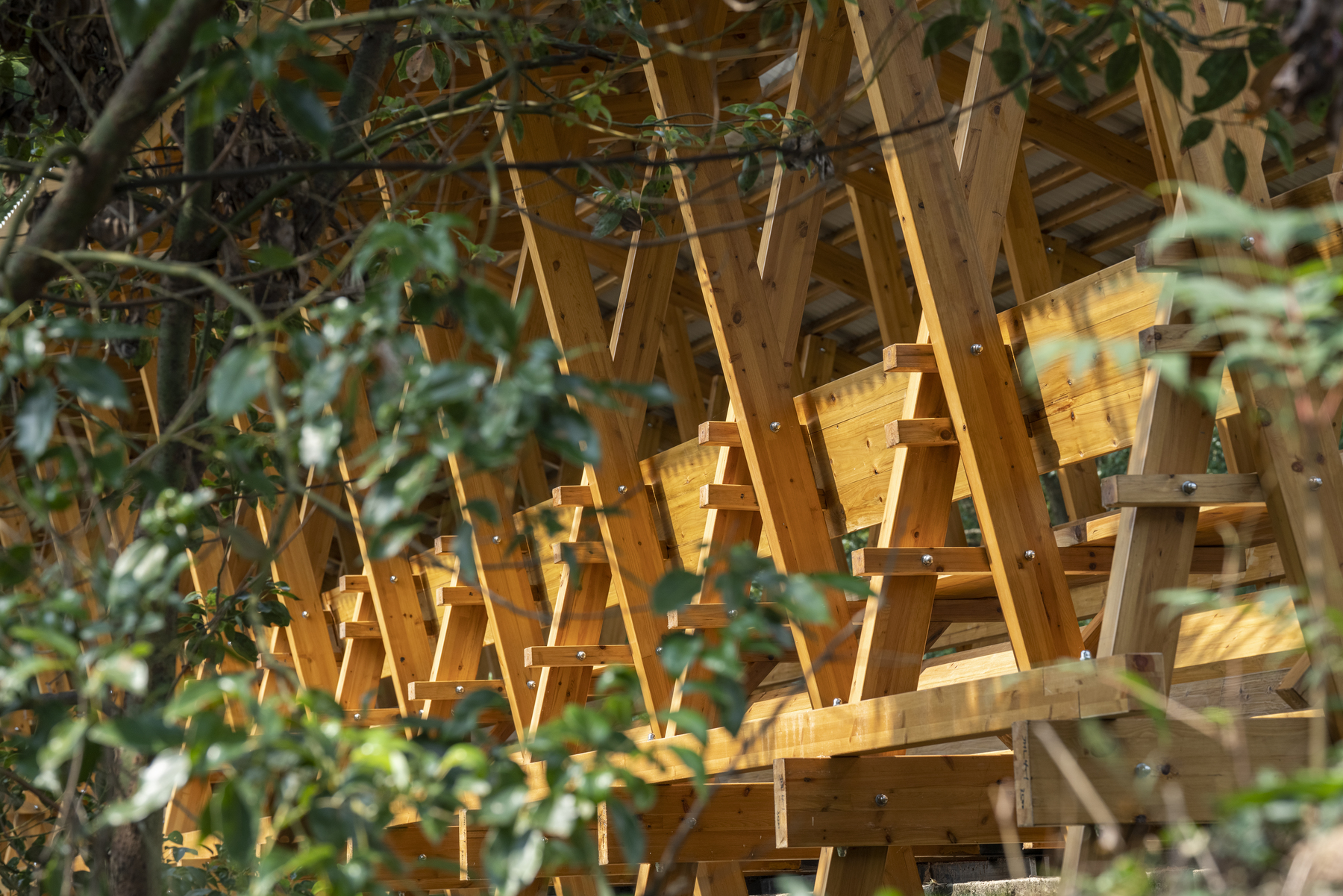
结构材料选择上,“水渠廊桥”采用了工厂预制的工程木(CLT)。作为新型材料,工程木(CLT)具有受力均匀、轻质高强、节约木材、绿色环保等优势,新型材料的介入也为古老的村庄注入新的活力。设计后的桥体由19榀小截面交叉结构单元组成,单元间距1.25米,形成缠绕于老水渠的密肋体系。每榀结构单元由两组独立的交叉柱组成,撑起各自的屋面,两片不同斜度的屋面之间形成一道脱开的缝隙,加强空气对流,优化桥体通风效果,同时起到瞬间大风的卸载作用,有利结构整体安全。非结构部分的材料则采用本地杉木,适应乡土场景中建造可能发生的变化。
In terms of material selection, the "Covered Bridge on Aqueduct" utilizes prefabricated cross-laminated timber (CLT). As a new material, CLT offers advantages such as uniform stress distribution, high strength-to-weight ratio, wood conservation, and environmental friendliness. The introduction of this new material injects fresh vitality into the ancient village. The bridge structure, after design, consists of 19 small cross-sectional interlocking units, with a unit spacing of 1.25 meters, forming a ribbed system intertwined with the old aqueduct. Each structural unit is composed of two independent X-shaped columns that support their respective roofs. The two roofs with different slopes form an open gap between them, enhancing air circulation, optimizing the bridge's ventilation effect, and providing instantaneous wind relief, contributing to overall structural safety. The non-structural components of the bridge are made of locally sourced cedar wood, adapting to the local rural scene.



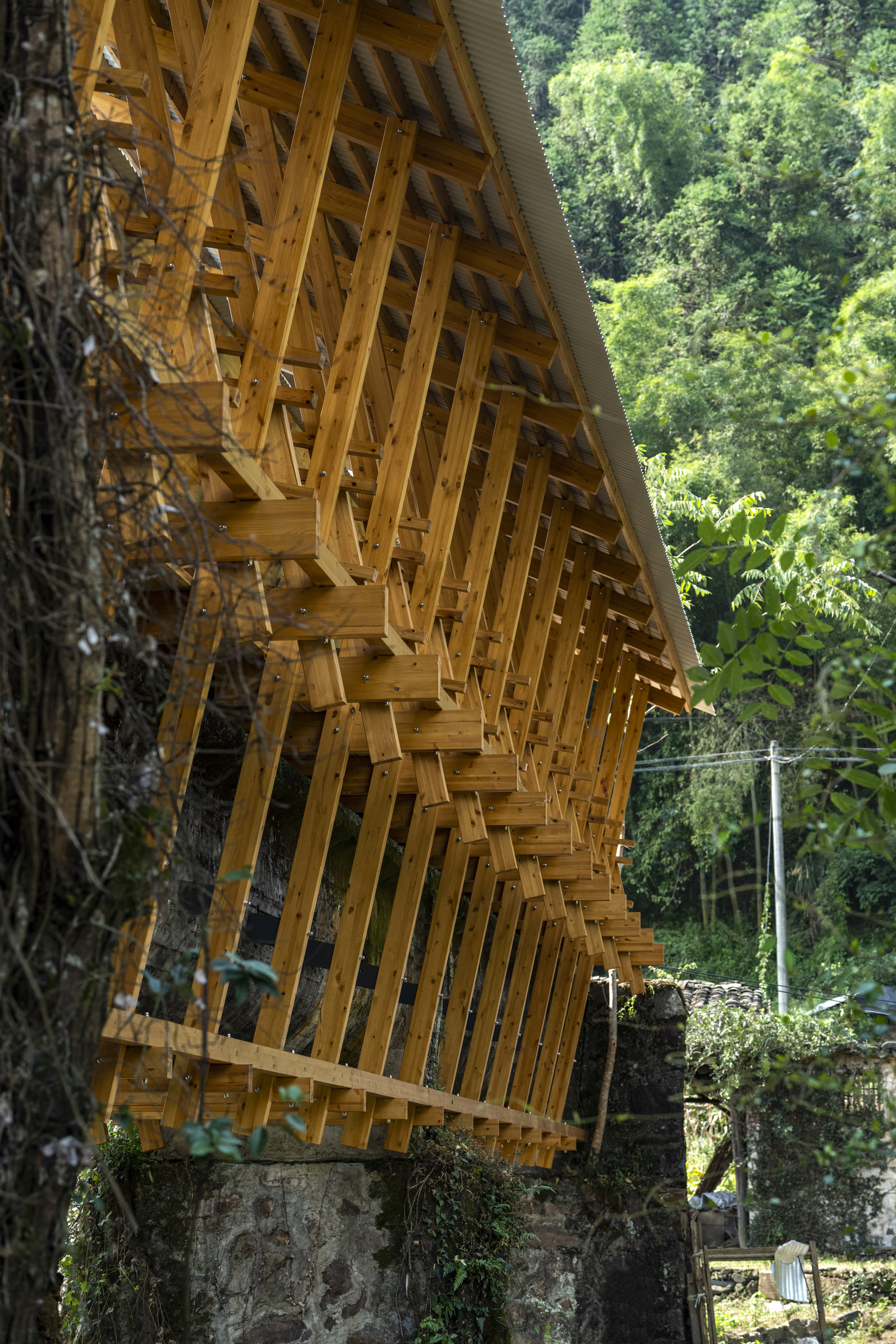
屋面采用轻薄的小波纹板材,轻轻落于木结构之上,灰白色的亚光铝合金材料,经适度的反射,与周遭环境融为一体,弱化廊桥的体量感。桥内两侧分别为座椅和高低两排靠椅,为村民提供不同休憩和观景的选择,同时也形成天然的“防护栏板”,保证使用安全。
The roof employs lightweight corrugated panels, delicately resting on the wooden structure. The gray-white matte aluminum alloy material, through moderate reflection, integrates with the surrounding environment, mitigating the visual mass of the bridge. On both sides inside the bridge, there are seats and two rows of reclining chairs, providing villagers with different options for resting and enjoying the view. Additionally, they act as natural "protective barriers," ensuring safety during use.
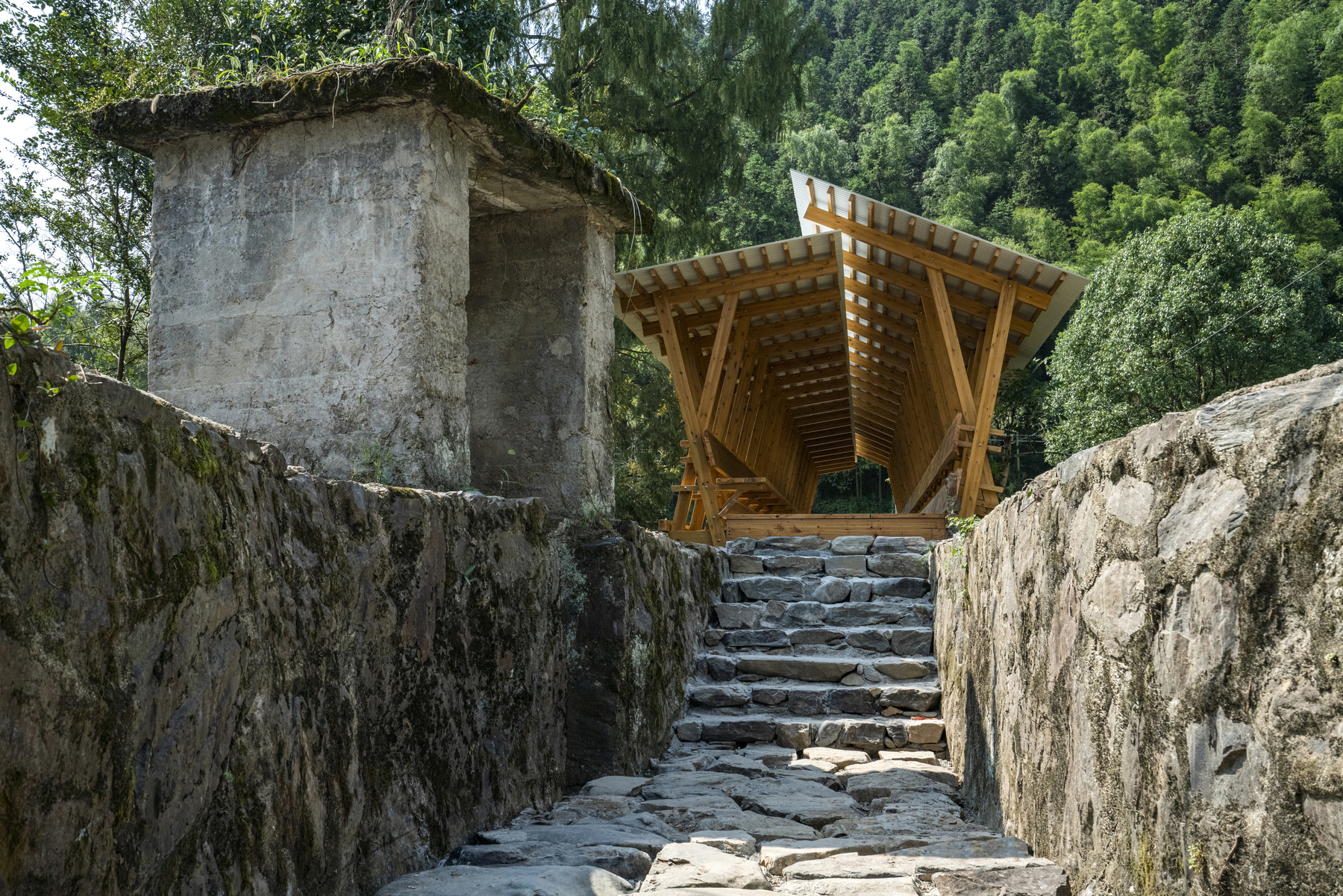
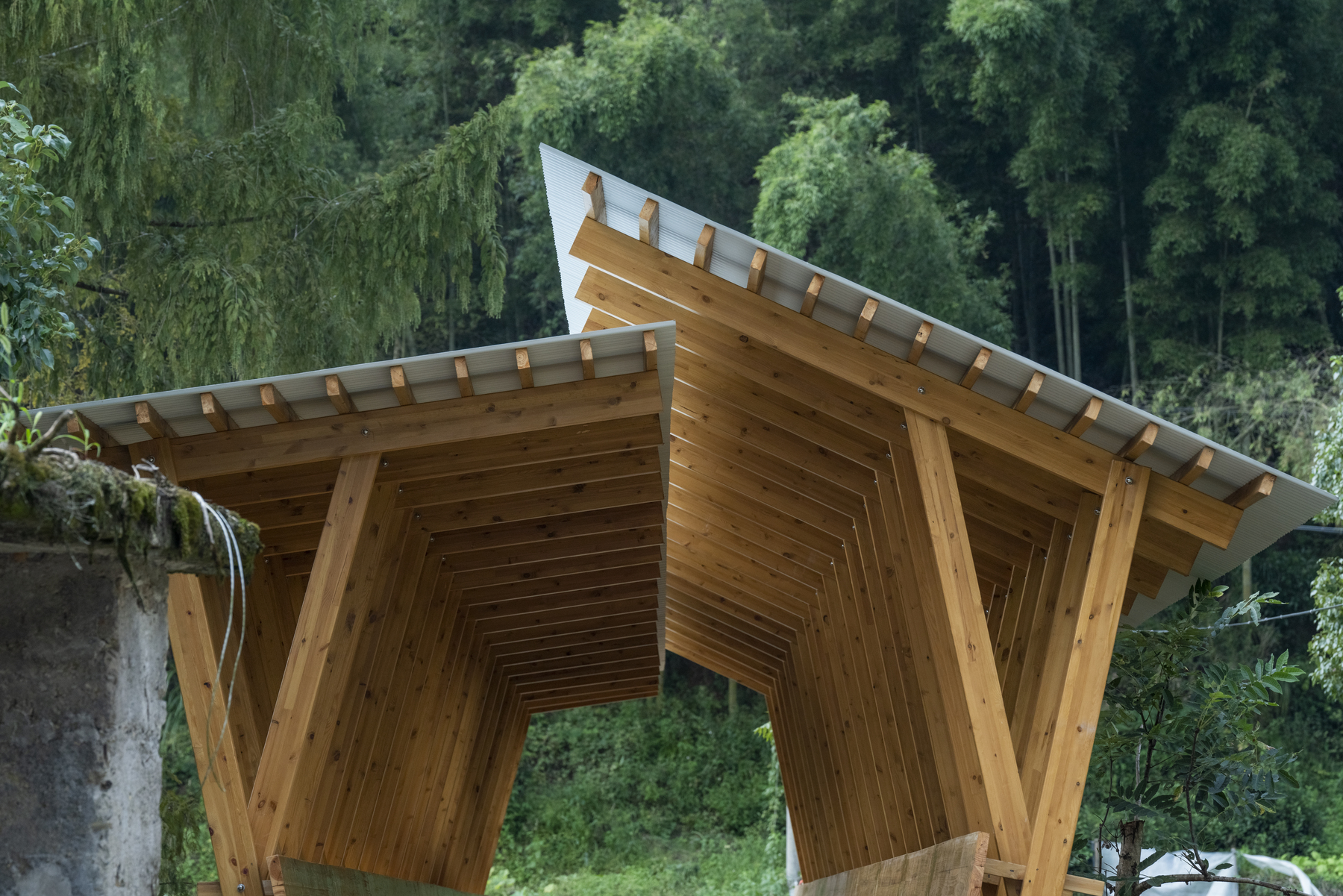

建造方面,“水渠廊桥”所有构件人手可抬,避免大型施工工具进场,最大化保护了村庄现有环境。木构之间的所有节点通过一颗螺栓轻巧联结,方便现场快速拼装。另外,我们将座椅、靠椅的固定方式与交叉柱节点构造需求相结合,使得家具也成为结构整体稳定的一部分。
In terms of construction, all components of the “Covered Bridge on Aqueduct" can be lifted by hand, avoiding the need for large construction tools, thereby maximizing the preservation of the village's existing environment. All joints between wooden components are connected with bolts for easy on-site assembly. Furthermore, the fixing methods for the benches are integrated with the structural requirements of the X-shaped columns, making the furniture an integral part of the overall stability.
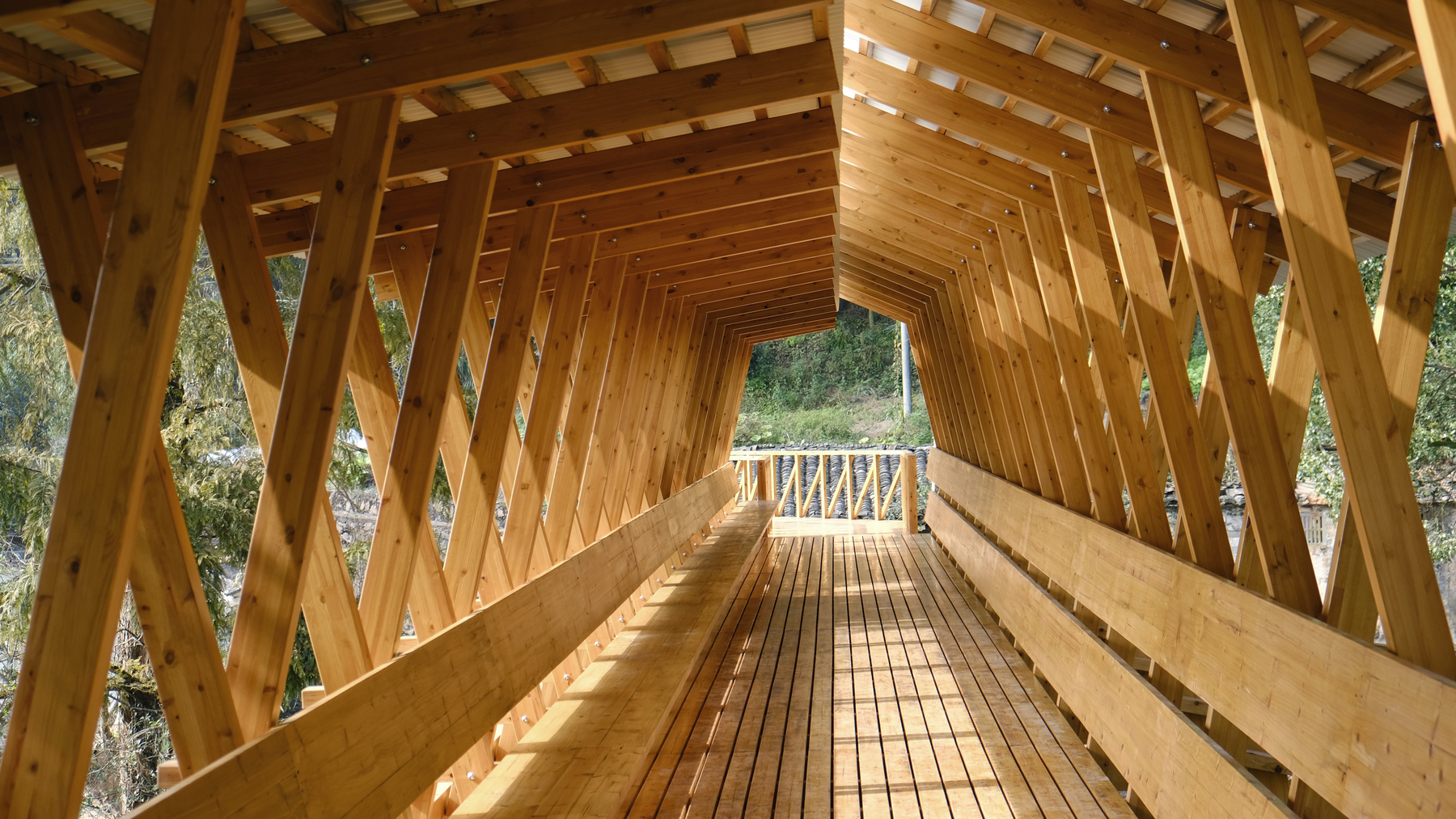
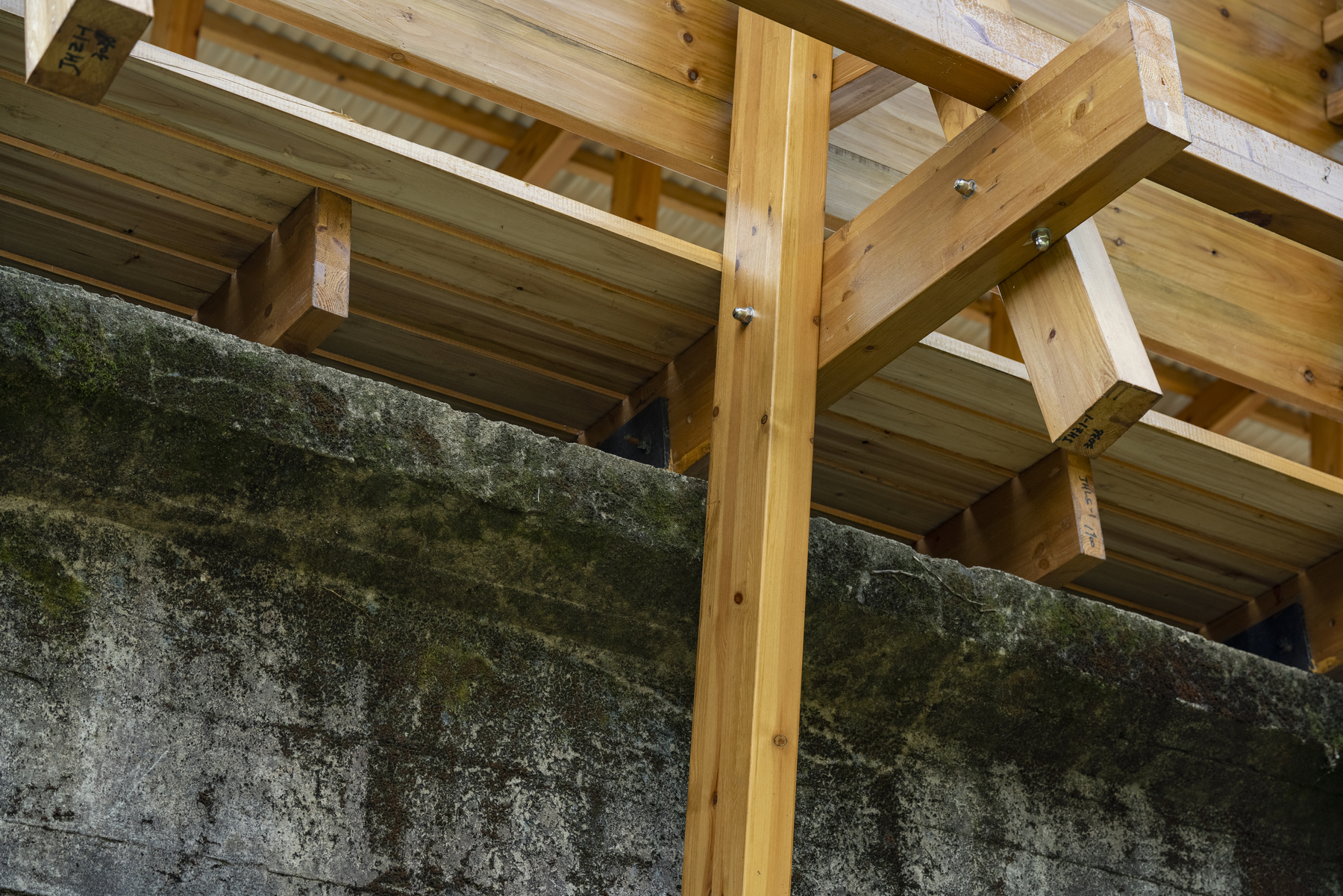
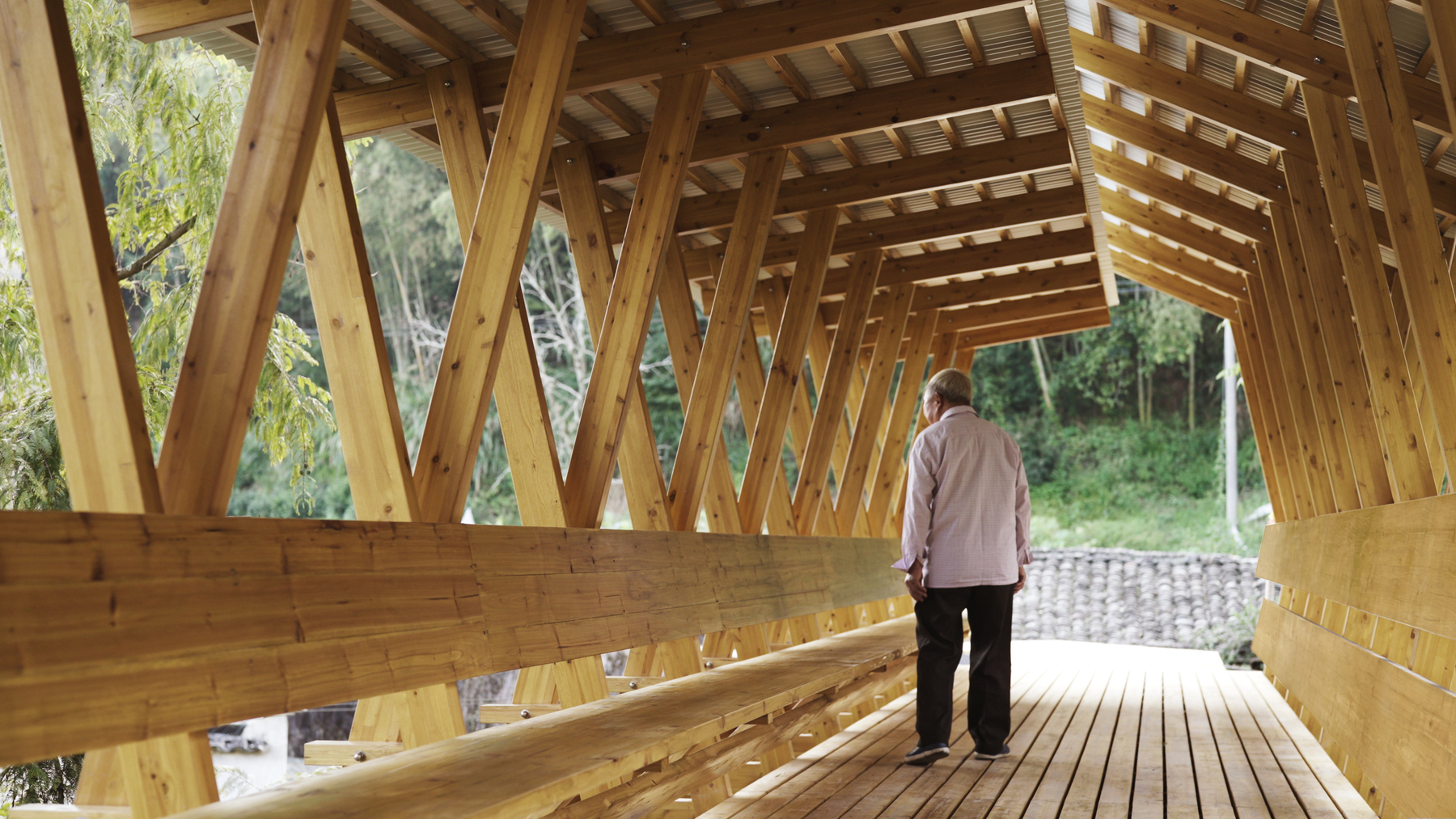

在场地设计上,两端的石构水渠成为廊桥的出入口,与村庄道路相接,从曾经走水到如今走人,当人们真切触摸水渠毛石与厚厚青苔上那深沉的岁月时,进入廊桥的过程则变成对一段特定历史的体验。出入口地面铺装所用的石材选自丰溪河内,河水将山体常年冲刷下来的天然石料搬运到丰梧村,如今又成为了这个新基建一部分,融入到村民公共生活。
In the site design, the stone-built water channels at both ends serve as the entrance and exit of the bridge, connecting to the village roads. The transition from delivering water to foot traffic turns the process of entering the corridor into an experience of a rich history, as people touch the moss-covered stones and feel the weight of time. The paving stones at the entrance and exit are collected from the Fengxi River. Eroded by the constant flow of water down the mountains and transported to Fengwu Village, these natural stones now become a part of this new infrastructure, integrating into villagers’ community life.


完成后的廊桥,像新生的藤蔓一样,轻轻缠绕依附在老水渠沧桑的躯体之上。这是对村庄那段特定历史的尊重与追忆,为村庄的未来创造一隅呵护与聚集的空间,更给丰梧村村民的公共生活注入了生机与活力。
Upon completion, the bridge, like newly grown vines, gently intertwines around the weathered body of the old aqueduct. It serves as a respectful tribute and a reminder of a specific history in the village. It also provides a nurturing and gathering space for the village's future, injecting vitality and vigor into the public life of Fengwu Village.
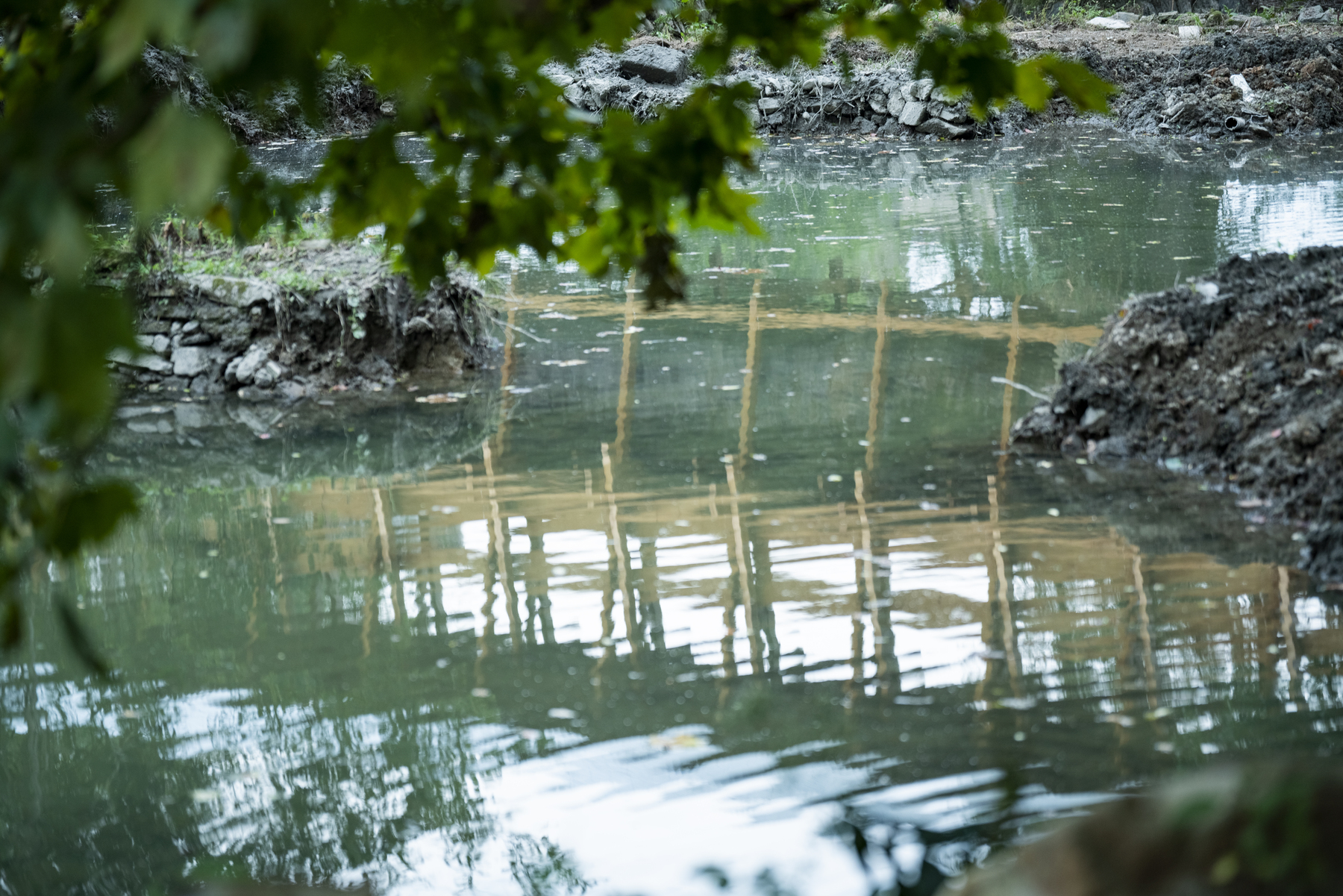
设计图纸 ▽

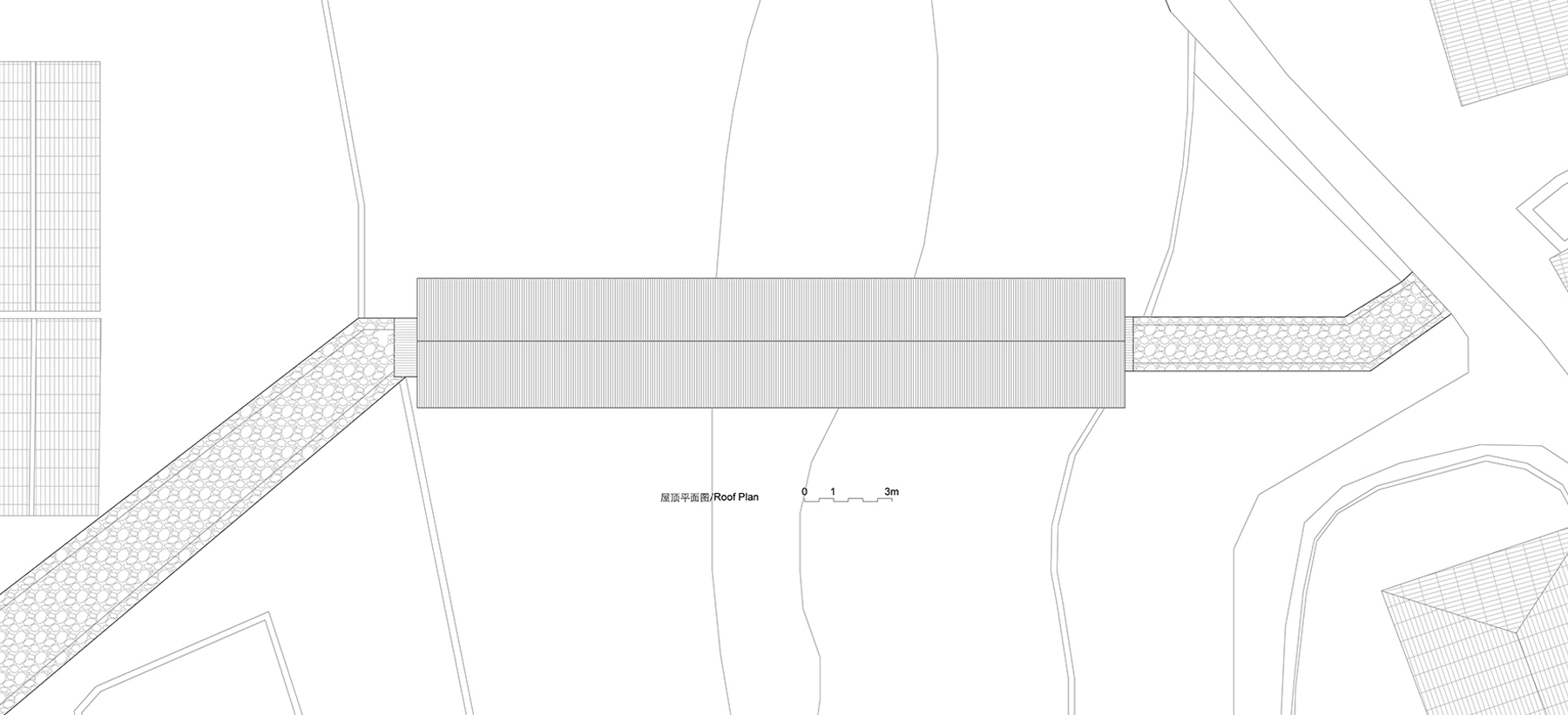


完整项目信息
工程名称:丰梧季·水渠廊桥
地点:安徽省黄山市黟县丰梧村
业主单位:碧阳镇人民政府、黟县农业农村水利局
建筑设计:IARA设计研究事务所
项目主持设计:刘鲁滨、张靓秋
项目团队:李虹润、吴心然、罗霖、罗沁铭
木结构技术支持:武汉林榔木建筑工程科技有限公司、武汉满木科技有限公司
施工单位:黄山德弘建设工程有限公司
建筑面积:105.6平方米
结构类型:现代木结构
设计时间:2023年3月
施工时间:2023年10月
摄影:宋惠恩、吴心然
版权声明:本文由IARA设计研究事务所授权发布。欢迎转发,禁止以有方编辑版本转载。
投稿邮箱:media@archiposition.com
上一篇:回旋的砖壳:红砖概念图书馆 / HCCH合尘建筑
下一篇:破除边界:衢州礼贤未来社区商品房 / gad杰地设计